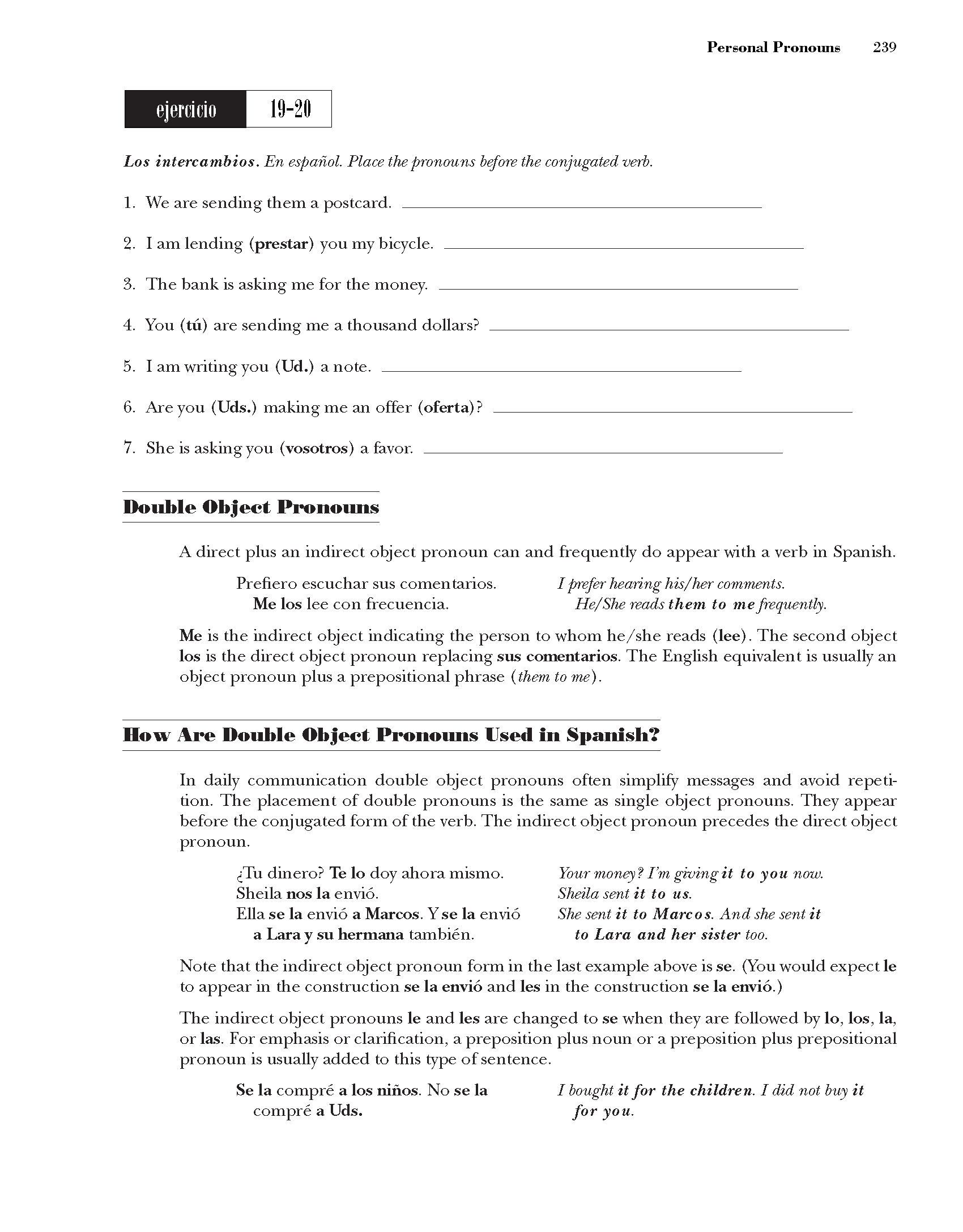CSG250

Personal Pronouns
239
ejercicio
Los intercambios. En espahol. Place thepronouns before the conjugated verb.
1. We are sending them a postcard. _
2. I am lending (prestar) you my bicycle. _
3. The bank is asking me for the money. _
4. You (tu) are sending me a thousand dollars? _
5. I am writing you (Ud.) a notę. _
6. Are you (Uds.) making me an offer (oferta)? _
7. She is asking you (vosotros) a favor. _
Double Object Pronouns
A direct plus an indirect object pronoun can and frequently do appear with a verb in Spanish.
Prefiero escuchar sus comen tarios. I prefer heańng his/her comments.
Me los lee eon frecuencia. He/She reads them to me freąuently.
Me is the indirect object indicating the person to whom he/she reads (lee). The second object los is the direct object pronoun replacing sus comentarios. The English equivalent is usually an object pronoun plus a prepositional phrase (them to me).
How Are Double Object Pronouns Used in Spanish?
In daily communication double object pronouns often simplify messages and avoid repeti-tion. The placement of double pronouns is the same as single object pronouns. They appear before the conjugated form of the verb. The indirect object pronoun precedes the direct object pronoun.
<:Tu dinero? Te lo doy ahora mismo. Sheila nos la envió.
Ella se la envió a Marcos. Yse la envió a Lara y su hermana tambien.
Your money? Fm givingit to you now. Sheila sent it to us.
She sent it to Marcos. And she sent it to Lara and her sister too.
Notę that the indirect object pronoun form in the last example above is se. (You would expect le to appear in the construction se la envió and les in the construction se la envió.)
The indirect object pronouns le and les are changed to se when they are followed by lo, los, la, or las. For emphasis or clarification, a preposition plus noun or a preposition plus prepositional pronoun is usually added to this type of sentence.
I bought it for the children. I did not buy it for you.
Se la compre a los ninos. No se la compre a Uds.
Wyszukiwarka
Podobne podstrony:
CSG246 Personal Pronouns 235ejercicio En espańol. Write both possible constructions for gerundio + d
50 mployeur et un salarie. Etant donnę , le delegue du personnel peut saisir mmes siegeant en r
Epreuve personaelle.LETTRE A M. ROLIN-JAEQU£MYNS Redacteur en chef de ia Revue du Droit Internationa
1. INTRODUCTION Depuis Papparition de la grandę oeuvre d’un personnage celebre -Comenius-Didactica M
D Gray Man v01 c007 p193 COmUNOPO PEL LABORATORIO PEL PIRECTOR KOM Ul PERSON/ OUE ESCRIBIÓ ŚSTO. £S
Skanuj0013 26 Lekcja trzecia — Es sabrosisimo. Me gustaria poder ver-los a todos e
Skanuj0031 62 Lekcja ósma en la zarzuela? 8. iCómo son los vestidos en la zarzuela y cómo en la oper
Skanuj0052 104 Lekcja czternasta nia? 4. iQuć se dice de los bosąues en generał? 5. iQue clase de śr
więcej podobnych podstron